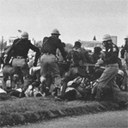0010 Fixing Images: Civil Rights Photography and the Struggle Over Representation
Identifiers (Article)
Identifiers (Files)
Abstract
"Fixing Images" argues that the iconic photographs of civil rights played a key role in limiting the racial reforms of the 1960s. The famous photographs of dogs and fire hoses turned against peaceful black marchers in Birmingham, or of tear gas and clubs wielded against voter-rights marchers in Selma are routinely credited with galvanizing the sympathy of liberal whites in the north for the plight of blacks in the south and of smoothing the way for civil rights legislation. What goes unsaid is how the photographs moved whites to accept legislative and social reforms by perpetuating a picture of white control. The article illustrates how white sympathy was contingent on images that consistently displayed blacks as the passive and hapless victims of active and violent whites. And it demonstrates how the iconic images of civil rights ultimately limited efforts to enact – or even imagine – reforms that threatened to upend the racial balance of power.
Statistics


License

This work is licensed under a Creative Commons Attribution-NonCommercial-NoDerivatives 4.0 International License.



